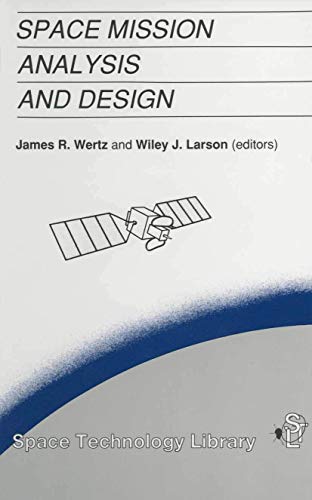
Inhaltsangabe
The goal of this book is to allow you to begin with a "blank sheet of paper" and design a space mission to meet a set of broad, often poorly defined, objectives. You should be able to define the mission in sufficient detail to identify principal drivers and make a preliminary assessment of overall performance, size, cost, and risk. The emphasis of the book is on low-Earth orbit, unmanned spacecraft. However, we hope that the principles are broad enough to be applicable to other missions as well. We intend the book to be a practical guide, rather than a theoretical treatise. As much as possible, we have provided rules of thumb, empirical formulas, and design algorithms based on past experience. We assume that the reader has a general knowledge of physics, math, and basic engineering, but is not necessarily familiar with any aspect of space technology. This book was written by a group of senior engineers with over 800 years of collective space experience. It reflects the insight gained from this practical experience, and suggests how things might be done better in the future. From time to time the views of authors and editors conflict, as must necessarily occur given the broad diversity of experience. We believe it is important to reflect this diversity rather than suppress the opinions of individual authors.
Die Inhaltsangabe kann sich auf eine andere Ausgabe dieses Titels beziehen.
Críticas
But as a reference volume for system engineers and satellite designers it would appear to be an invaluable collection of data.
The Aeronautical Journal
Reseña del editor
The goal of this book is to allow you to begin with a "blank sheet of paper" and design a space mission to meet a set of broad, often poorly defined, objectives. You should be able to define the mission in sufficient detail to identify principal drivers and make a preliminary assessment of overall performance, size, cost, and risk. The emphasis of the book is on low-Earth orbit, unmanned spacecraft. However, we hope that the principles are broad enough to be applicable to other missions as well. We intend the book to be a practical guide, rather than a theoretical treatise. As much as possible, we have provided rules of thumb, empirical formulas, and design algorithms based on past experience. We assume that the reader has a general knowledge of physics, math, and basic engineering, but is not necessarily familiar with any aspect of space technology. This book was written by a group of senior engineers with over 800 years of collective space experience. It reflects the insight gained from this practical experience, and suggests how things might be done better in the future. From time to time the views of authors and editors conflict, as must necessarily occur given the broad diversity of experience. We believe it is important to reflect this diversity rather than suppress the opinions of individual authors.
„Über diesen Titel“ kann sich auf eine andere Ausgabe dieses Titels beziehen.
Weitere beliebte Ausgaben desselben Titels
Suchergebnisse für Space Mission Analysis and Design: 2 (Space Technology...
Space Mission Analysis and Design (Space Technology Library)
Anbieter: Wonder Book, Frederick, MD, USA
Zustand: Very Good. Very Good condition. A copy that may have a few cosmetic defects. May also contain light spine creasing or a few markings such as an owner's name, short gifter's inscription or light stamp. Artikel-Nr. E19F-00288
Space Mission Analysis and Design (Space Technology Library)
Anbieter: Revaluation Books, Exeter, Vereinigtes Königreich
Paperback. Zustand: Brand New. 849 pages. 8.75x6.00x1.50 inches. In Stock. Artikel-Nr. zk0792309715
Neu kaufen
Anzahl: 1 verfügbar
Space Mission Analysis and Design
Anbieter: preigu, Osnabrück, Deutschland
Taschenbuch. Zustand: Neu. Space Mission Analysis and Design | Wiley J. Larson (u. a.) | Taschenbuch | 2 Taschenbücher | Englisch | 1991 | Springer | EAN 9780792309710 | Verantwortliche Person für die EU: Springer Verlag GmbH, Tiergartenstr. 17, 69121 Heidelberg, juergen[dot]hartmann[at]springer[dot]com | Anbieter: preigu. Artikel-Nr. 107100430
Neu kaufen
Anzahl: 5 verfügbar

